The Oddly Pedestrian Life of Christopher Chaos – Review!
Sean Dillon: The first thing that jumps out at you when reading The Oddly Pedestrian Life of Christopher Chaos is the title. The art of title making, especially within comics, is an often overlooked practice. Typically, a work will call itself after a central character (Asadora!), location (Redfork), or thematic element (Revenge). However The Oddly Pedestrian Life of Christopher Chaos opts to go for a longer title.
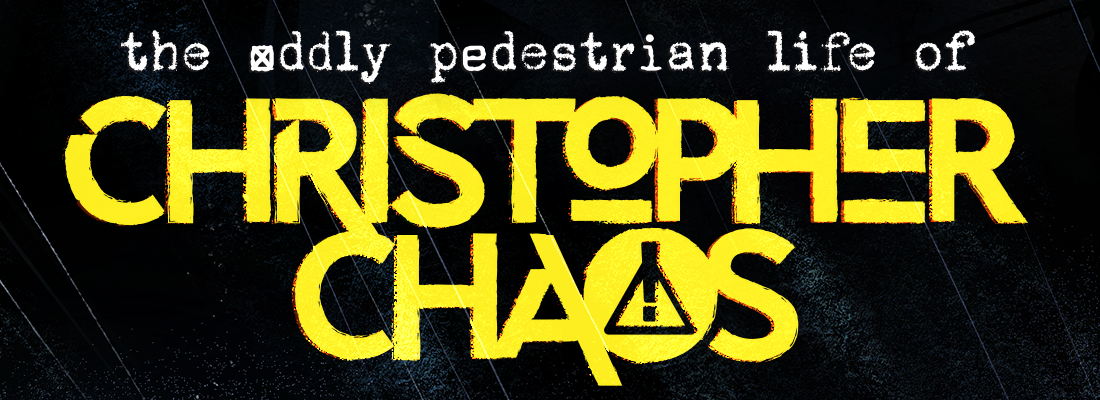
This isn’t necessarily a unique trait within the sphere of fiction, but it remains a tricky process to fully pull off. The trick is to be just long enough to be evocative without going too long into farce. Compare and contrast Bring Me the Head of Alfredo Garcia to The Incredibly Strange Creatures Who Stopped Living and Became Mixed-Up Zombies!!? The former title presents the viewer with a hook for the narrative. Who wants the head of Alfredo Garcia? Who is Alfredo Garcia? In contrast, the latter is just word salad.
The Oddly Pedestrian Life of Christopher Chaos opts to go for the former. Consider the phrase “Oddly Pedestrian Life.” For many people, a pedestrian life is to be expected. But for someone named Christopher Chaos, a comic book name up there with Peter Parker and Donnie Darko, life will most likely not go in that direction. But by explicitly drawing attention to this aspect of Christopher Chaos’ life, the reader is hooked by its implications. Will it be a mundane story about someone with a rather intriguing name? An ironic statement to contrast with the weirdness of Christopher Chaos’ life? Or is it a contextual statement, made in relation to the world Christopher Chaos inhabits? The reader is left wanting to see what the answer will be.
By the end of the first issue, the answer becomes abundantly clear.
Ritesh Babu: The gorgeous Nick Robles cover helps in this case. It contextualizes the nature of the work wonderfully well. You see that title, and then you see the artwork it’s laid on-top of, and you have a very clearly expressed idea.
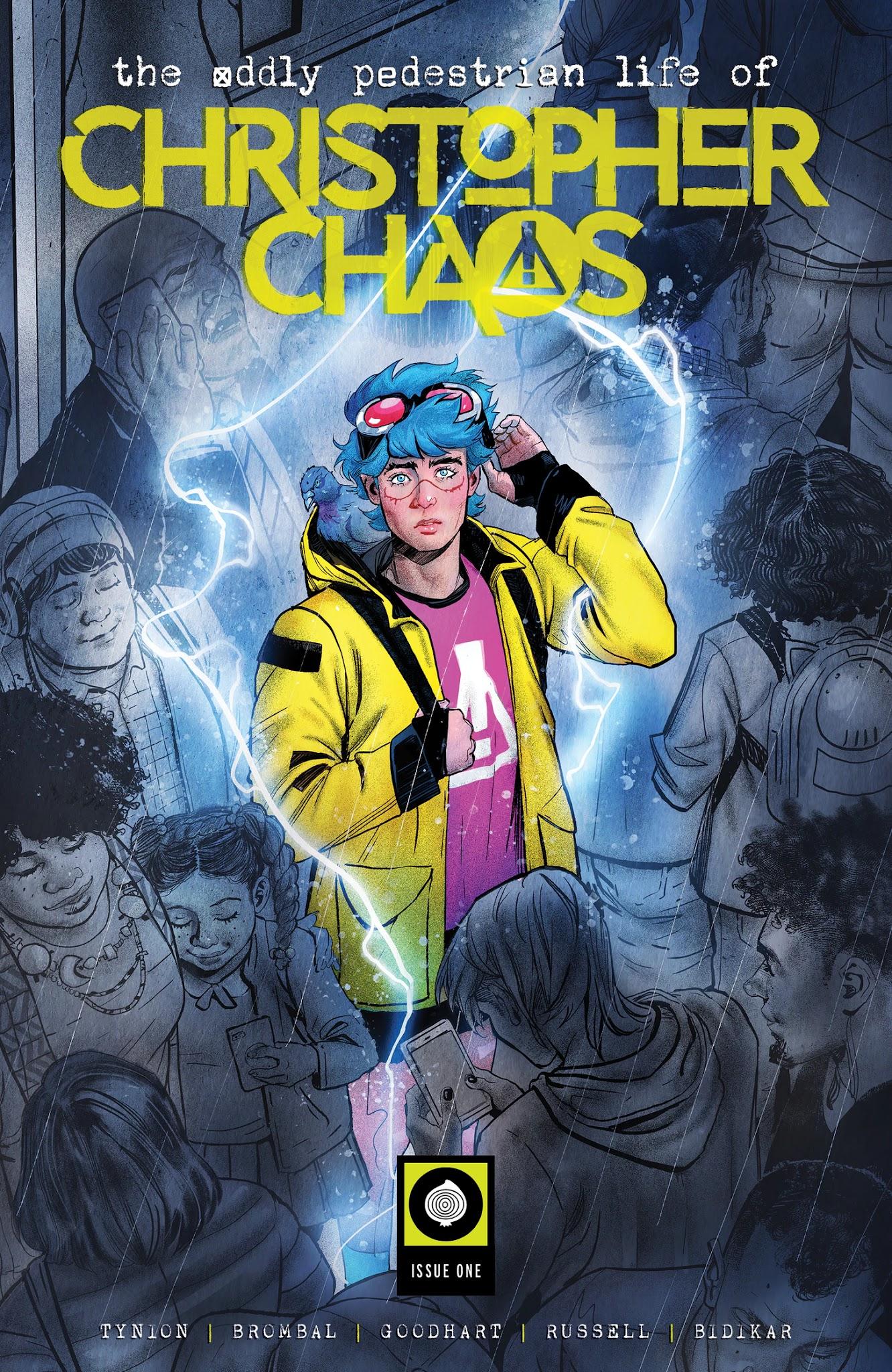
You see a world mired in grays, in the mundane, colorless void of the everyday. And amidst all of that, you see the sparkling figure of color surrounded by the spark of divine lightning. You see Christopher Chaos.
You see this boy in a bright pink shirt with a danger/warning sign on it (which I love being integral to even the very slick logo). And then you have the yellow to match and go with that. It almost evokes the sense of a hazmat suit in that shade, at a first glance. And then you have his bright-red goggles, as well as that line across his face. In an ordinary world, in a pedestrian world, he’s someone special. He stands out. All of the people we see on the cover are looking down or away, walking on about, caught in the hustle-and-bustle of the everyday.
All except Christopher Chaos. Who’s looking up and right at us. That’s a statement right there.
Sean: You know a Christopher Chaos. You’ve met this kid in your high school classroom, awkwardly fidgeting in his seat. You’ve seen this kid on the street muttering louder than she thinks she is. You’ve talked to this kid and they’ve chewed your ear off about various irrelevant facts about the universe. You are reading the words of a Christopher Chaos right now.
People like Christopher Chaos are not, and can never be, normal in a non-pedestrian world. I pause at the cover Ritesh has put into the document, and it occurs to me that the word pedestrian also refers to someone who walks on a developed road. Though the image is static, the body language of everyone is in movement. Everyone, that is, save Christopher Chaos. He is not a pedestrian. The world does not want people like Christopher Chaos to be normal. It needs its monsters
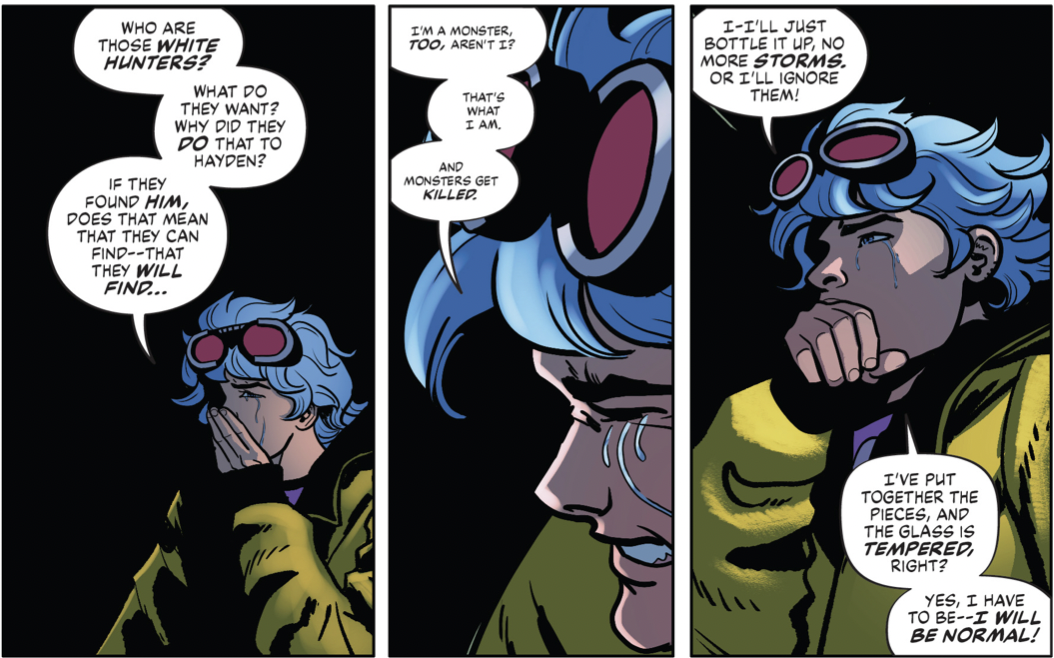
There are many quotes about the nature of monsters and their relationship with neurodivergent thought and normality. Elizabeth Sandifer once wrote on the subject of Grant Morrison’s Doom Patrol:
“The party had to end, and had to end for the exact reason Mr. Nobody said in his dying words—that people don’t want a strange and magical world of madness and wonder. They want to get up, go to work, and vote for George fucking Bush. And so the sudden and violent turn into that, with John Dandy unleashed and everything going terribly and brutally wrong for the Brotherhood of Dada, was inevitable. Because that’s what normal people have: safety. In the end, this is what happens to the queers and the madmen of the world: the cops come and shoot them dead.”
There are people who act differently; who are special in the wrong way. Who is touched. Who is gifted. Who is autistic. Many see people like the one providing these words to you and shudder in horror. How dare they be in public, goes through many minds, though rarely consciously enough to notice. They’re probably going to kill someone, even if it’s just themselves. Someone ought to find a solution to their issues so they can be normal.
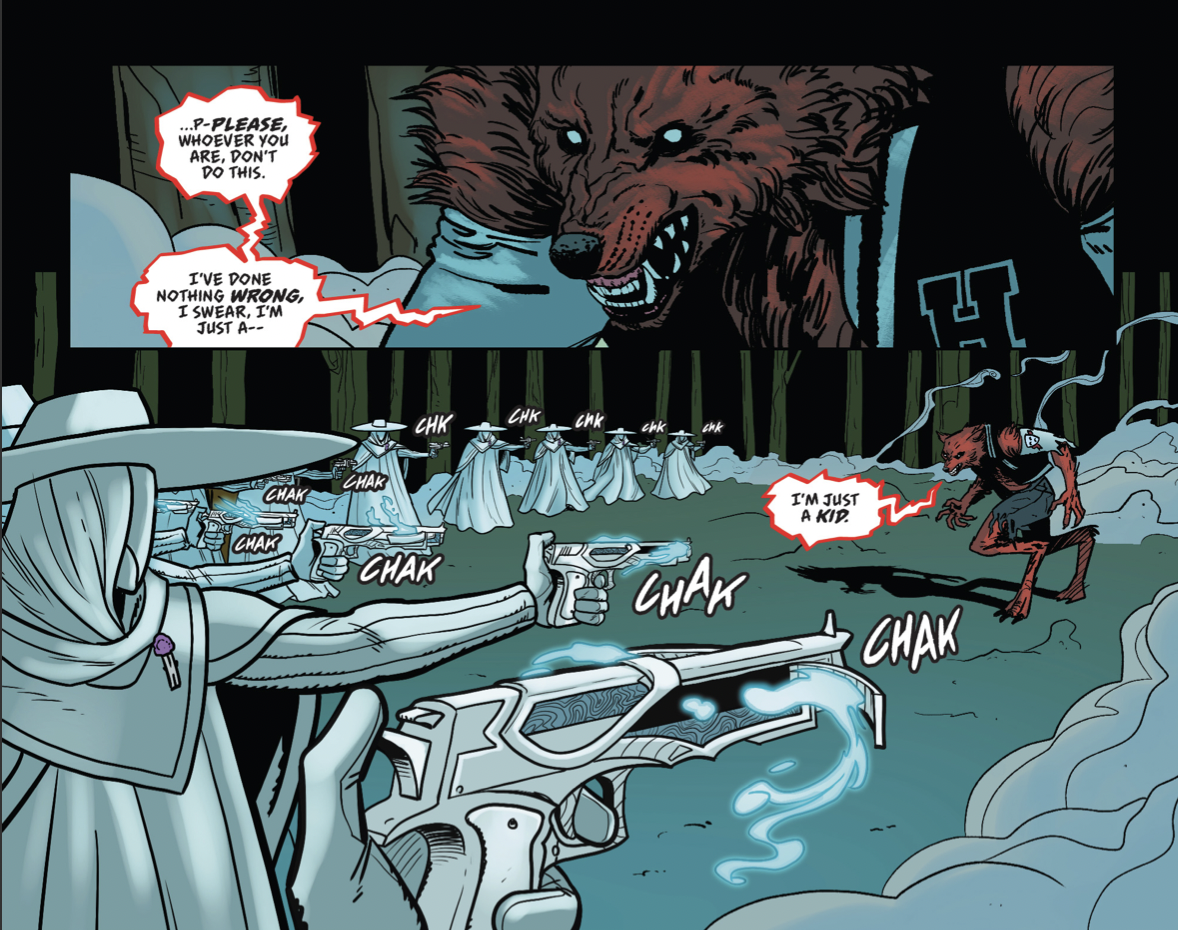
Of course, the neurodivergent are just as capable of being horrible as the neurotypical. In a parallel to Hayden, whose tragic end was met in the image above, I too have seen neurodivergent people in public and reacted with shame. I can pass as a normal person from time to time, communicate with them like any other “normal” person can. But at various points in my life, I have interacted with neurodivergent people who can’t. Whose neurodivergency is more visible to the naked eye. And I had a disquieting feeling. As if I was seeing myself in a funhouse mirror. A wrong version of me who was nevertheless me. And I’d feel uncomfortable until they’re gone. Then I start feeling guilty and ashamed of myself. At that moment, I acted normally towards a monster.
Perhaps it’s befitting, then, that Christopher’s dad is the only son Victor Frankenstein ever had.
Ritesh: The premise of this book is so big brain. It’s so dang good. We have Frankenstein’s Monster from Mary Shelly’s classic book, which is really considered to be the root of Science-Fiction in general. Then we have Tom Swift, which Alan Moore himself positions as the marker of Science-Fiction hitting America, really.
So on one hand you have the root of Classic Science-Fiction and one the other hand you have the root of American Science-Fiction. And now you bring them together in a wild, galaxy brain premise that’s kind of like ‘What if Frankenstein’s Monster was involved in the origins of a queer neurodivergent Tom Swift-esque inventor kid?’ Which is to say:
What if Frankenstein’s Monster had a queer son?
It’s the reversal of the “mad-scientist makes the monster” classic. The monster makes the mad-scientist.
And it’s a book that explicitly leans into the inherent queerness of the “monster” characters and “monstrosity,” whilst being tied to the legacy of the very first iconic literary monster of them all! It’s kind of genius, really.
Sean: Perhaps the most interesting aspect of this is in this image:
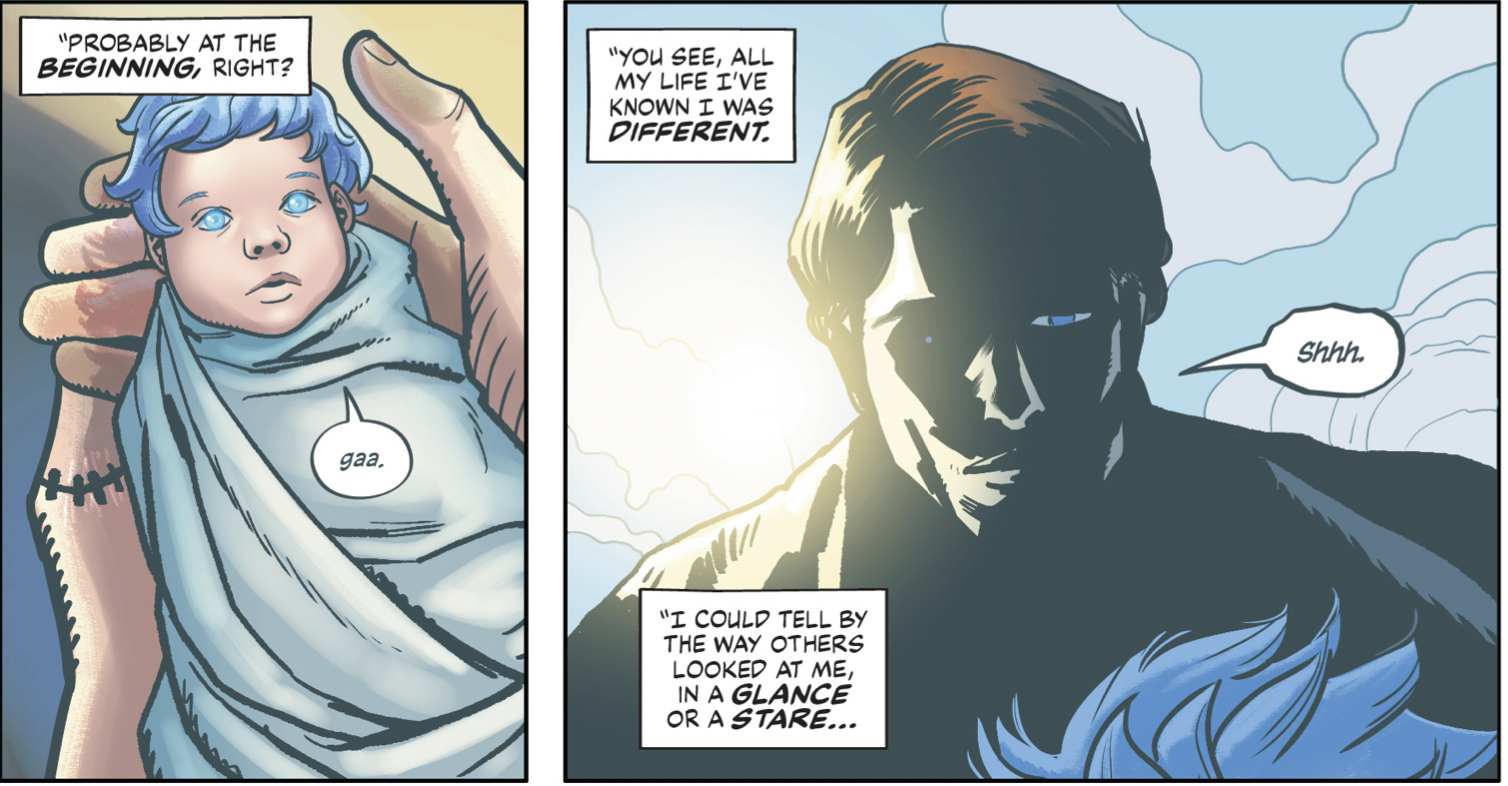
While later depictions of Adam Frankenstein (as well as in the prologue) have him in the more Byronic imagery typically used to depict Frankenstein’s Monster (in Shelly’s book), there’s a degree of Jack Kirby within this image of Frankenstein silhouetted by the sun. The angularity of the jaw line, the blocky fingers. It’s not to the degree of Kirby’s work (you can likewise see the Byronic nature of Adam in his piercing blue eyes and soft lips), but the ghost nevertheless lingers within.
Kirby, of course, was famous for his monsters. From the repressed and destructive Hulk to the self loathing yet optimistic Ben Grimm to the discarded son of Darkseid, Orion. We come to understand, empathize, and even develop a fondness for these characters who many would typically react with fear and derision. By this specter’s presence, intentionally or not, we place Christopher Chaos into a legacy of monsters. One birthed by a child whose father abandoned him out of fear and lashed out at the world in kind.
By making Christopher a Tom Swift type, the nature of his monstrosity shifts. There’s the old internet joke that growing up means forgetting that the Doctor was the monster in the book. The mad scientist who sees the rules of nature–god–and breaks them, leading to catastrophe and horror. A villain whose curiosity leads him to bend further and further to horror, until human morality is rejected because everyone and everything is a prop for his own egomania.
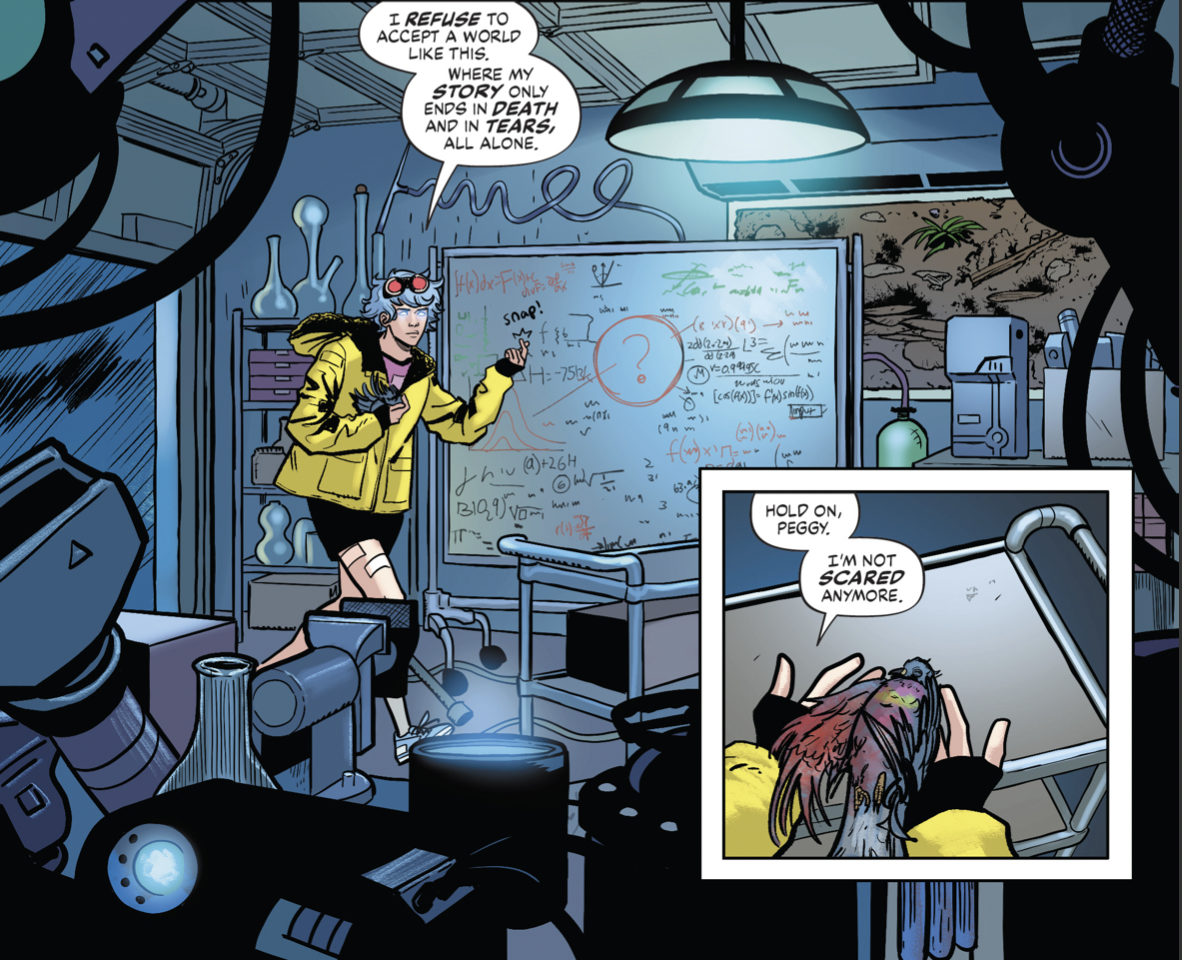
What’s interesting, then, is the phrasing. Typical mad scientists opt to go for doing the horrible things that they do for the sake of power or the sheer achievement of their actions. Christopher Chaos, by contrast, does it because he’s realized the fundamental truth of the world’s idea of normality: it sucks. The rules are arbitrary and always hurt those who are marginalized. Why should we have to follow rules that would see pigeons dead? That would kill teenagers for existing? That would make people like me hate ourselves?
So he breaks the rules and brings the bird back to life.
And it is here, dear reader, that I fell in love.
Ritesh: I really love that you bring Kirby up. I recall James Tynion saying that this book would kinda be for queer horror peeps what Invincible was for everybody else. That it’s not a superhero work, but it is the thing most akin to a superhero work in a sense out of all that he’s publishing. And I totally see it and get what he means. Invincible was very much this 60’s DC Sci-Fi riff with Supermen who could shatter stars and a wide expansive cosmic superhero universe. And Christopher Chaos fits in with a 60’s comics root as well, albeit a different one.
You look at the Marvel Universe, this iconic construction that has now swept pop culture and rules over it as this massive force and juggernaut, and its roots are fascinating. Kirby was working on romance, horror and monster comics back in the 50’s. And you see how they would up influencing what he’d go onto help craft later. The melodrama, the sense of “monstrosity,” all that soapy character stuff made its way into what would become the Fantastic Four.
Because that’s the real difference between Kirby’s Challengers Of The Unknown at DC in the 50’s and Fantastic Four in the 60’s, yeah? The latter are monsters with that touch of romance. They’re not just cool badass adventure guys. They’re freaks hit by a cosmic accident. A guy’s on fire, a dude’s a bunch of rocks, another is super-stretchy. The “freakish” nature of it is key. The abnormality as opposed to the Challengers.
The Monsters are the basis and the bedrock of the Marvel Universe. And the monsters begin with Adam Frankenstein, the prototypical monster. So to bridge those strands here by doing this Adam Frankenstein legacy book in a Tom Swift mode for the medium and form Kirby was renowned for? Hell yeah! That’s super cool. I love that kind of fun lineage of influences, that collective amalgamation of strands.
It gives the book a sense of building forward, an invisible foundation that I love. This is a book in the tradition of 60’s Kirby Monsters, much like Invincible was 60’s DC Sci-Fi, but it’s very much a queer interpretation and lens on such an idea. And even more so, an explicitly queer presentation of it all in the hands of queer talent like James Tynion III, Tate Brombal, Nick Robles, Isaac Goodhart, and Aditya Bidikar.
But what I love even more is all the stuff we’re talking about. It’s not some homework and nor is it stuff you need to clock to have the work “click” or make sense. It’s just a very cool, smart book that’s super accessible and works on its own as a unit of storytelling. It’s for anyone and everyone. It’s super approachable.
Sean: For all that I’ve been highlighting the heavy themes of the book, it’s a lot of fun. While the first issue itself is low on non-horrific action, the prologue features an extremely dynamic chase sequence between Adam Frankenstein and the hunters. It’s only three pages long, but Bromball and Goodhart use their space effectively.
It’s a book about a mad scientist breaking the rules of the world. But the world itself is mad in its attempt to stem the madness. For all that people might try to stomp us down–to break us into a million little pieces, bury us alongside the dirty little secrets they’d rather keep from the world to keep it spinning–we won’t go down without a fight. It’s a healthy reminder that while pride is a party, there isn’t a party worth attending that isn’t a riot!
Ritesh: I love that opening chase sequence so much. Isaac Goodhart is so dang good. Because we first open on a boxed-up reality that gives you a claustrophobic sense that Chris is trapped. We’re trapped. We’re all bound up and locked in this world. And then that page hits, and suddenly the boxes and flat order are replaced with gigantic images with dimensionality. These are unbound, they cover the entire width of the page, and they have more “weight,” they feel more three-dimensional, much more “real.” The chaos rings true in a way “order” does not.
The entire book is so deeply queer, with the queerness built and baked into every single possible layer and aspect of the story. The story is explicitly queer on an intrinsic level, and the book is about exploring and examining what that means or how that feels. I’ve read enough queer stuff wherein sometimes it’s a lot of…shallow, surface level statement of things that feels rather like this. You’ll get hit with like a two page Claremontian dialogue-dump covering the page in what feels like a Twitter thread put to page. It’s all just…blunt statements, rather than the careful, considered construction of a smart story mechanism to meaningfully express and explore those ideas as potent art. It feels obvious and lazy to me when I see it, and it’s just not for me.
Which is also why I adore Tate Brombal’s work. He aims high, the work is deeply, explicitly queer and the way he integrates and uses genre fiction frameworks and setups to speak to very real things like history and queer experience is just so satisfying to me? He gets it. It’s no surprise that Tynion, who similarly gets it and makes deeply and explicitly queer work, would hire Brombal as a collaborator. It’s like the difference between reading work that needs to say “This is about family” fifty times instead of doing anything worthwhile with that, and a work that never needs such blunt statements or didacticism, because of course it’s about family. It is constructed on every single level, in every single relationship, in every conflict and struggle and every choice it makes to express that essence.
Christopher Chaos, much like Brombal’s prior Barbalien (also lettered by the ever-excellent Aditya Bidikar), is a book steeped in the experience of being queer. It is about being the absolutely neurotic, anxious mess of a queer teenager. An experience we can all understand and relate to. Only it, y’know, has more Werewolves, Frankensteins, and crazy Cult Cops Of Complicity that want to help enforce the normalcy of the world.
I can’t wait to see where it goes next.
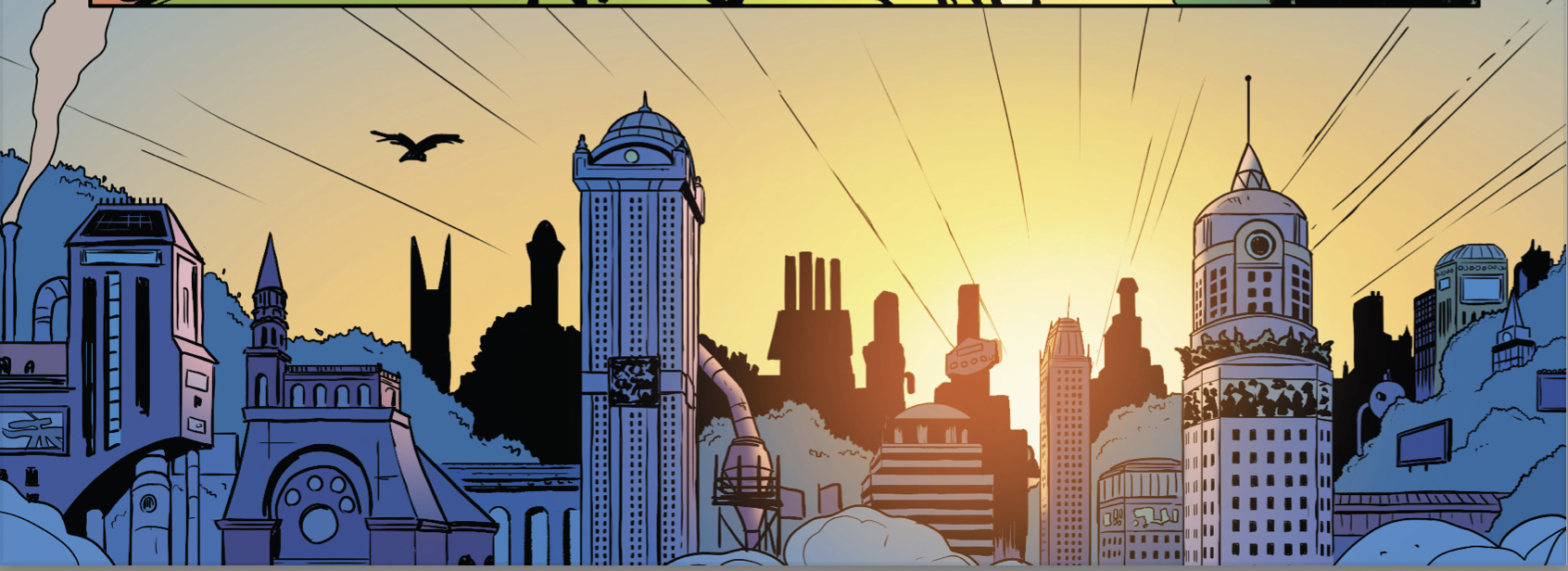
The post The Oddly Pedestrian Life of Christopher Chaos – Review! appeared first on Comic Book Herald.